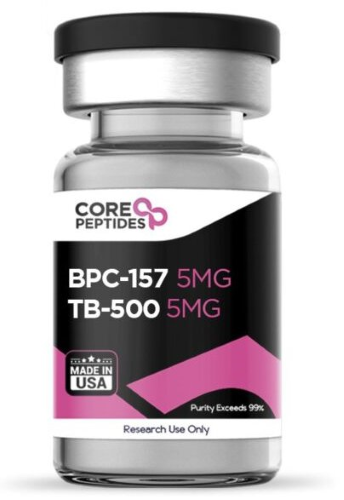Body Safety Compound-157 Improves Alkali-burn Injury Healing In Viv Dddt Much more remarkably, BPC-157 is very secure and resistant to hydrolysis or enzyme food digestion, also in the stomach juice. Furthermore, it is easily dissolved in water and requires no service provider for its application.13 These findings indicate that BPC-157 might come to be a. restorative agent for the therapy of chemical-induced shed wound. Previous studies have actually shown that BPC-157 advertises the recovery of different cells, including skin,36 muscular tissue,15,37-- 39 bone,40 tendon,41 and tendon42 in different animal designs. As a whole, blockage of the analytical and cerebellar cortex, hypothalamus/thalamus, and hippocampus was observed, with edema and large locations with boosted varieties of karyopyknotic https://mylesjosl.bloggersdelight.dk/2024/08/04/bpc-157-and-blood-vessels-bentham-scientific-research/ cells, along with intracerebral hemorrhage, mostly in the infratentorial area, affecting the cerebello angle/area (Figures 12, 13, 14, 15). We noted an increased number of karyopyknotic cells in all 4 areas, i.e., the cerebral and cerebellar cortex, hippocampus, and hypothalamus/thalamus (Number 14). Especially, there was karyopyknosis and degeneration of Purkinje cells of the cerebellar cortex and significant karyopyknosis of pyramidal cells in the hippocampus. Generalized edema and blockage (a, b, c, d) with a raised number of karyopyknotic cells were found in the cortex (a, b) that was significantly various from the cortex location in BPC 157-treated rats (A, B). In control rats, intracerebral hemorrhage was located in infratentorial room (d), primarily in cerebellopontine angle/area (c) with generalised edema and blockage of central nerve system, while no hemorrhage (C) and just light edema was located in treated animals, primarily at 50 mmHg intra-abdominal stress (D). ( HE; zoom × 200, range bar 100 μm (a, A, b, B, d, D); magnifying × 100, scale bar 200 μm (c, C)). Body-protective compound (BPC) 157 shows safety results versus damage to different body organs and tissues. For future medical applications, we had previously established a solid-phase synthesis procedure for BPC157, validated its organic activity in various wound designs, and completed preclinical security examinations. This study intended to examine the pharmacokinetics, discharging, metabolic rate, and circulation accounts of BPC157. Stomach area disorder appeared as a numerous occlusion syndrome that can not be stayed clear of unless therapy was given. Routinely, mutual changes in the stomach, thoracic, and mind dental caries (Depauw et al., 2019) quickly appeared as determinants of vascular failure. Therefore, in the rats with intra-abdominal hypertension, multiorgan failure (i.e., intestinal, mind, heart, liver, and kidney sores), portal and caval hypertension, aortal hypotension, intracranial (exceptional sagittal sinus) high blood pressure, and generalised apoplexy showed up. This resulted in generalised tension, generalised Virchow set of three discussion, and serious ECG disturbances; therapy was able to provide ample compensation (i.e., activation of collateral paths to reestablish blood circulation), both quick and continual, as demonstrated with BPC 157 treatment. As a prime and practical verification, rats with significant vessel ligation and occlusion, in either artery and/or capillary, and either peripherally or centrally, displayed a similar disorder (Vukojevic et al., 2018; Gojkovic et al., 2020; Kolovrat et al., 2020; Gojkovic et al., 2021a; Knezevic et al., 2021a; Knezevic et al., 2021a; Knezevic et al., 2021b). Hence, there may be a shared inability to respond, resulting in natural vascular failing upon significant vessel occlusion (ligation) (Vukojevic et al., 2018; Gojkovic et al., 2020; Kolovrat et al., 2020; Gojkovic et al., 2021a; Knezevic et al., 2021a; Knezevic et al., 2021a; Knezevic et al., 2021b) along with upon the induction of high intra-abdominal pressure, with all vessels pressed. Together with blood vessel feature, we a minimum of have toconsider leak of fluid/proteins/plasma, causing edema/exudate click here formation as well as thrombogenesis. In this facet, we have neoangiogenesis causing pathological vascularization, vascular invasionresulting in launch of metastatic cells and the sensation of homing resulting in formation of additional growths-- metastases. BPC-157 is a peptide that has actually been revealed to be efficient in decreasing joint discomfort, enhancing joint flexibility, boosting recovery from injuries, recovery skin burns, and musculotendinous injuries.
Animals
Additionally, we did not conduct metabolite analysis in tissues, especially in target organs, owing to the small sample size. The analysis of metabolites in tissues is important for further pharmacodynamic examination of BPC157 and explanation of its efficacy. Next, we examined the primary metabolites of [3H] BPC157 in urine gathered from 0 to 8 h and from 8 to 72 h and in bile and feces accumulated from 0 to 72 h after management.Examining Its Regenerative Effects On Tissues
- There is some proof to recommend that BPC-157 may enhance cognitive function, especially in the context of brain injuries or neurodegenerative conditions.Embarking upon the molecular enlightenment of BPC-157's impact, its complex communication with bodily systems resembles an interwoven collection of signals and actions.Compared to version control, BPC-157-treated teams revealed a considerable recovery reaction similar to that of the bFGF-treated group.BPC 157 (GEPPPGKPADDAGLV, molecular weight 1,419; Diagen, Slovenia) was prepared as a peptide with 99% high-performance fluid chromatography (HPLC) purity, with 1-des-Gly peptide being the main contamination.When BPC-157 involves with its target receptors, it's not merely a fleeting touch but a transformative occasion.
BPC-157 and TB-500: Inflammation, Tissue Damage, and More - The Portugal News
BPC-157 and TB-500: Inflammation, Tissue Damage, and More.


Posted: Tue, 19 Sep 2023 07:00:00 GMT [source]
Does BPC 157 reduce inflammation?
BPC-157 has been shown to have anti-inflammatory residential or commercial properties and can help reduce swelling. Studies have actually revealed that BPC-157 can decrease the manufacturing of pro-inflammatory cytokines and increase the manufacturing of anti-inflammatory cytokines. This can help reduce inflammation and enhance overall digestive tract health.